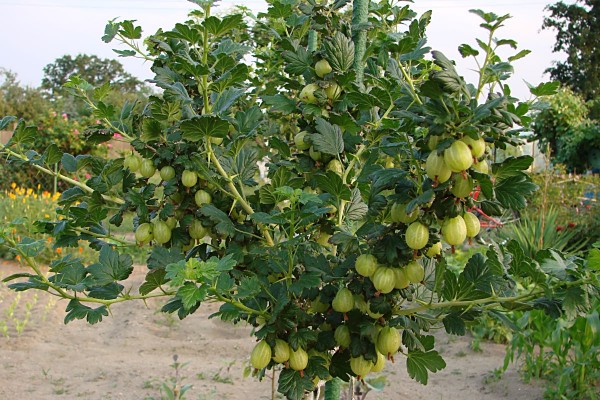 GOOSEBERRY
GOOSEBERRY
One of the most popular fruit shrubs grown in our gardens and allotments is gooseberry, whose noble varieties were bred from species that grow in the natural state, mainly from the common gooseberry, wild in Europe and American gooseberries. The advantage of the American gooseberry is this, that it has almost thornless shoots and is resistant to mildew. Gooseberry noble varieties have an erect habit, spherical or spreading. Young shoots are prickly, from the older ones the spines fall off. The gooseberry bushes are alive 20-30 lat, and even longer. Gooseberry fruit often referred to as the "grapes of the north"”, they are a very good raw material for making compotes, preserves and jams. They are also eaten fresh, especially some early varieties, characterized by a very good taste.
Gooseberry is a plant that is not very unreliable in cultivation, as a rule, it gives high yields, actually cultivated and cared for – very high. Gooseberries contain sugars, organic acids, pectins, tannins, nitrogen compounds, vitamins (B, trace amounts of A and, above all, C.). In addition, gooseberries contain potassium, phosphorus, calcium and iron.
Gooseberry belongs to frost-resistant plants and can bear fruit even in the north-eastern part of Poland. Proper planting of gooseberries and skillful management of it (like a tree on a stump – grafted on golden currant) will make, that the spikes will not interfere with the harvesting of fruit and it will be easy to remove unnecessary shoots. By planting the right varieties, we can extend the time of fruit ripening. We have a choice 5 varieties recommended for allotment and home gardens.
The earliest Henninga is a German variety, which gives an outstandingly dessert fruit. They are suitable for making wines and jams. It is one of the most valuable early varieties. It matures in the Lublin region at the end of June. The fruit ripens evenly, do not fall off before harvesting. The bush grows strongly, its habit is compact. Straight shoots, Thick, erected, with thickly embedded bristles, all covered with thorns. Single to triple spikes, Long, red at the base, perpendicular to the shoot. Light gray bark on old shoots. Leaves of medium size or small, very characteristic, yellow-green color, three-flap, clearly innervated. Leaf edge notched. It comes to fruiting in the third year after planting. It bears fruit every year, profusely. It is quite sensitive to the American gooseberry mildew. The fruit is medium or small, spherical, seated singly or in pairs. Light yellow skin, with very distinct veins, densely covered with short and soft bristles, soft, thin. Yellowish flesh, juicy, sweet and wine, very tasty.
The Red Triumph is an English variety, ripening medium early, almost evenly. After ripening, the fruit does not fall off and can remain on the bush for several weeks. Fruits are suitable for all kinds of preserves, and to be eaten raw. The bush grows very strongly, it has a hemispherical habit, a bit spread out, loose. Medium-thick shoots develop, straight or arched at the top. Single spikes, double or triple, medium length and medium thickness. Medium-sized leaves, leathery, Dark green, shimmering, when they are young, have a reddish tinge on top, densely mossy underneath. Leaf edges folded up, coarsely and bluntly serrated. It starts bearing fruit in the second year after planting, fully, it bears abundantly in 5-6 year. Sensitive to the American gooseberry mildew, but under optimal conditions this fungus is absent. The fruits are quite large, weight approx. 15 g, changeable shape and size, oval, ovoid or spherical, with a short, thick shank. Red rind, and fully ripe – dark purple, quite thick, strong, densely furry or sparsely covered with bristly hairs, sometimes naked with a wax coating.
White Triumph – also an English variety. The bush grows strongly, its habit is compact, produces long shoots, almost vertical, annuals – light gray in color, biennial – characteristically pale bark. Single to triple spikes, red at the base on non-lignified shoots. Large or medium-sized leaves, light green, Shiny, five-flap. Sharply scratched flaps. Leaf edges toothed. This variety fully enters the fruiting period in the third year after planting. It bears fruit very profusely, regularly, yielding large fruit, spherical, seated singly or in pairs. Light green peel, strongly mossy, with veins. Greenish flesh, very tasty, sweet and wine. The fruit is suitable for direct consumption, and for preserves. Medium early variety.